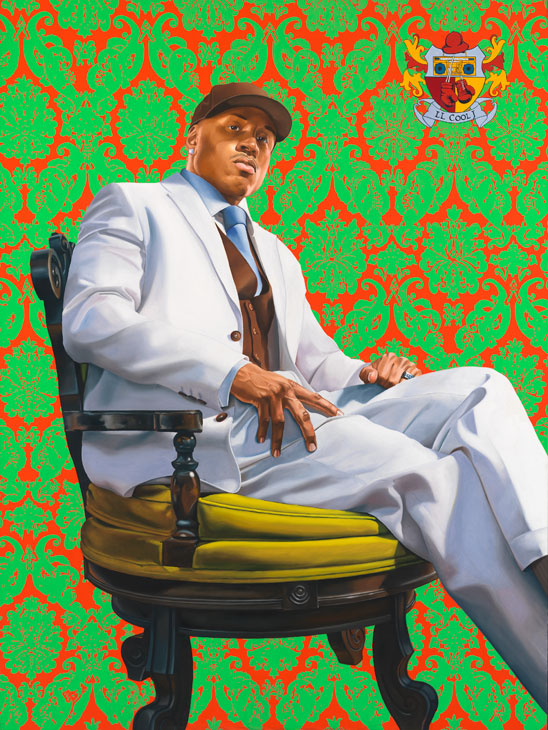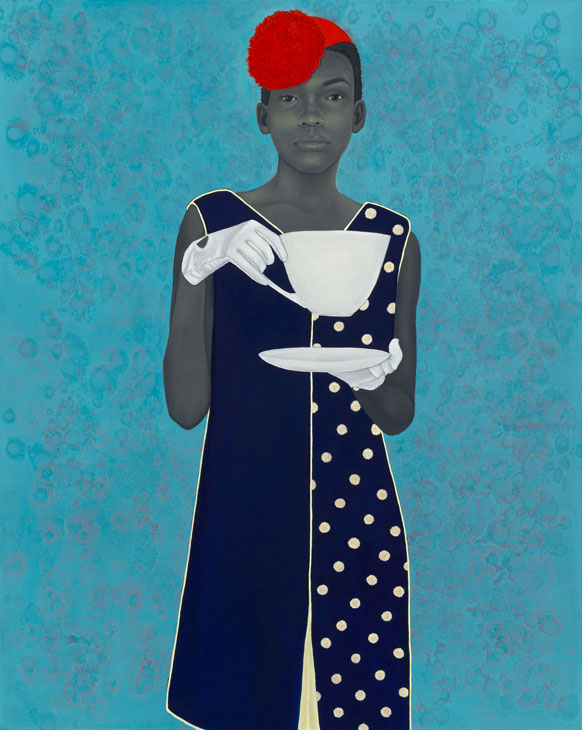Last week, former U.S. president Barack Obama and first lady Michelle Obama named the artists who will paint their official portraits for the National Portrait Gallery in Washington, D.C. Commentators who looked forward to learning how the Obamas, noted patrons of the arts, would shake up the stuffy establishment tradition of (white, male) artists depicting (white, male) presidents were not disappointed. Kehinde Wiley, a portraitist famed for depicting African Americans he meets on the streets in the manner of European masters, will paint the former president, while Amy Sherald, who recently won the National Portrait Gallery’s Outwin Boochever Portrait Competition, will capture Mrs Obama’s likeness.
As Roberta Smith pointed out in the New York Times, the Obamas’ choice of artists reflects both their longstanding dedication to highlighting the work of African-American artists and their ‘instincts for balancing the expected and the surprising, and for being alert to painting’s pertinence to the moment.’ The Obamas chose Wiley and Sherald from a thick portfolio of potential artists that was compiled by National Portrait Gallery curators. While 39-year-old Wiley has been making waves in the art world for some years with his irreverent and majestic portraits, earning a recent retrospective at the Brooklyn Museum and a U.S. national tour, 44-year-old Sherald is far less known. A resident of Baltimore, Maryland, who put her art career on hold for years while caring for sick relatives and recovering from her own heart transplant, Sherald was a last-minute addition to Mrs Obama’s candidates.

LL Cool J (2005), Kehinde Wiley. National Portrait Gallery, Smithsonian Institution; on loan from LL Cool J. © Kehinde Wiley
Wiley and Sherald share an interest in ‘using the power of images to remedy the historical invisibility of black men and women’, as Eugenie Tsai writes in the catalogue of ‘A New Republic’, Wiley’s recent touring exhibition. For Wiley, this means choosing contemporary African-American subjects and posing them as European nobles from Old Master paintings, but against vibrant, patterned backgrounds. In his famous painting Napoleon Leading the Army Over the Alps (2005), Wiley riffed on Jacques-Louis David’s triumphant equestrian portrait of the French leader. The conquering dictator is recast as a young black man in modern street clothes; Bonaparte’s gilded cuffs are replaced with red sweat bands that echo the ornate backdrop of scarlet and gold. As has been noted repeatedly by Wiley and critics alike, his work plays on the historical lack of black subjects in traditional art history; his ornamental and light-filled portraiture revels in the beauty of black bodies and depicts the pervasiveness of U.S. black culture in the world.
While Sherald is also engaged in puncturing racial divides, both social and artistic, her figurative style draws from the penetrating subjects of Norwegian painter Odd Nerdrum (with whom she completed a private study residency in 2005) and the potent use of colour that characterises the portraits of the late Barkley L. Hendricks. Miss Everything (Unsuppressed Deliverance), which won the National Portrait Gallery’s $25,000 portraiture prize in 2016, is representative of Sherald’s defiant subjects. The painting depicts a young black woman against a brilliant blue background. She wears a navy and white polka-dot dress, a red hat, and white gloves on her hands, which hold an oversized white teacup. The oil on canvas features Sherald’s signature technique of depicting skin tones in greyscale. Smith connects this practice with W.E.B. DuBois’s influential concept of ‘double consciousness’: the sense held by African Americans ‘of always looking at one’s self through the eyes of others,’ in DuBois’s words. He calls it ‘two-ness’, the dual and sometimes duelling identities of American and Black. (It’s little coincidence that the predominant colours in Miss Everything are red, white and blue.)

Miss Everything (Unsuppressed Deliverance) (2013), Amy Sherald. Frances and Burton Reifler. © Amy Sherald
In their attention to inequality and representation, identity and power, both Sherald and Wiley promise to intellectualise and usefully disrupt the most staid wing of the National Portrait Gallery. The last portrait added to the collection, Robert Anderson’s ‘informal’ rendering of George W. Bush beaming on a green couch at Camp David, is the 21st-century equivalent of Napoleon on his horse: a powerful man from a powerful family, giving the people the image they want of their leaders. (There was even a hint of the elite patronage system in Bush’s choice of artist; he and Anderson were old buddies from Yale.) It will be fascinating to see how the artists selected by the Obamas navigate the treacherous waters between respecting tradition and upending it, but it seems Sherald and Wiley are more than up to the task. As Wiley himself has stated, ‘The games I’m playing have much more to do with using the language of power and the vocabulary of power to construct new sentences. It’s about pointing to empire and control and domination and misogyny and all those social ills in the work, but it’s not necessarily taking a position. Oftentimes it’s actually embodying it.’

How paintings of the Obamas will shake up American portraiture
Miss Everything (Unsuppressed Deliverance) (detail; 2013), Amy Sherald. Frances and Burton Reifler. © Amy Sherald
Share
Last week, former U.S. president Barack Obama and first lady Michelle Obama named the artists who will paint their official portraits for the National Portrait Gallery in Washington, D.C. Commentators who looked forward to learning how the Obamas, noted patrons of the arts, would shake up the stuffy establishment tradition of (white, male) artists depicting (white, male) presidents were not disappointed. Kehinde Wiley, a portraitist famed for depicting African Americans he meets on the streets in the manner of European masters, will paint the former president, while Amy Sherald, who recently won the National Portrait Gallery’s Outwin Boochever Portrait Competition, will capture Mrs Obama’s likeness.
As Roberta Smith pointed out in the New York Times, the Obamas’ choice of artists reflects both their longstanding dedication to highlighting the work of African-American artists and their ‘instincts for balancing the expected and the surprising, and for being alert to painting’s pertinence to the moment.’ The Obamas chose Wiley and Sherald from a thick portfolio of potential artists that was compiled by National Portrait Gallery curators. While 39-year-old Wiley has been making waves in the art world for some years with his irreverent and majestic portraits, earning a recent retrospective at the Brooklyn Museum and a U.S. national tour, 44-year-old Sherald is far less known. A resident of Baltimore, Maryland, who put her art career on hold for years while caring for sick relatives and recovering from her own heart transplant, Sherald was a last-minute addition to Mrs Obama’s candidates.
LL Cool J (2005), Kehinde Wiley. National Portrait Gallery, Smithsonian Institution; on loan from LL Cool J. © Kehinde Wiley
Wiley and Sherald share an interest in ‘using the power of images to remedy the historical invisibility of black men and women’, as Eugenie Tsai writes in the catalogue of ‘A New Republic’, Wiley’s recent touring exhibition. For Wiley, this means choosing contemporary African-American subjects and posing them as European nobles from Old Master paintings, but against vibrant, patterned backgrounds. In his famous painting Napoleon Leading the Army Over the Alps (2005), Wiley riffed on Jacques-Louis David’s triumphant equestrian portrait of the French leader. The conquering dictator is recast as a young black man in modern street clothes; Bonaparte’s gilded cuffs are replaced with red sweat bands that echo the ornate backdrop of scarlet and gold. As has been noted repeatedly by Wiley and critics alike, his work plays on the historical lack of black subjects in traditional art history; his ornamental and light-filled portraiture revels in the beauty of black bodies and depicts the pervasiveness of U.S. black culture in the world.
While Sherald is also engaged in puncturing racial divides, both social and artistic, her figurative style draws from the penetrating subjects of Norwegian painter Odd Nerdrum (with whom she completed a private study residency in 2005) and the potent use of colour that characterises the portraits of the late Barkley L. Hendricks. Miss Everything (Unsuppressed Deliverance), which won the National Portrait Gallery’s $25,000 portraiture prize in 2016, is representative of Sherald’s defiant subjects. The painting depicts a young black woman against a brilliant blue background. She wears a navy and white polka-dot dress, a red hat, and white gloves on her hands, which hold an oversized white teacup. The oil on canvas features Sherald’s signature technique of depicting skin tones in greyscale. Smith connects this practice with W.E.B. DuBois’s influential concept of ‘double consciousness’: the sense held by African Americans ‘of always looking at one’s self through the eyes of others,’ in DuBois’s words. He calls it ‘two-ness’, the dual and sometimes duelling identities of American and Black. (It’s little coincidence that the predominant colours in Miss Everything are red, white and blue.)
Miss Everything (Unsuppressed Deliverance) (2013), Amy Sherald. Frances and Burton Reifler. © Amy Sherald
In their attention to inequality and representation, identity and power, both Sherald and Wiley promise to intellectualise and usefully disrupt the most staid wing of the National Portrait Gallery. The last portrait added to the collection, Robert Anderson’s ‘informal’ rendering of George W. Bush beaming on a green couch at Camp David, is the 21st-century equivalent of Napoleon on his horse: a powerful man from a powerful family, giving the people the image they want of their leaders. (There was even a hint of the elite patronage system in Bush’s choice of artist; he and Anderson were old buddies from Yale.) It will be fascinating to see how the artists selected by the Obamas navigate the treacherous waters between respecting tradition and upending it, but it seems Sherald and Wiley are more than up to the task. As Wiley himself has stated, ‘The games I’m playing have much more to do with using the language of power and the vocabulary of power to construct new sentences. It’s about pointing to empire and control and domination and misogyny and all those social ills in the work, but it’s not necessarily taking a position. Oftentimes it’s actually embodying it.’
Unlimited access from just $16 every 3 months
Subscribe to get unlimited and exclusive access to the top art stories, interviews and exhibition reviews.
Share
Recommended for you
Can TEFAF New York Fall reinvigorate interest in older art?
The fair’s second autumn edition in New York builds on last year’s success – and includes some extraordinary exhibits
Rockwell family sues Berkshire Museum over deaccession plans
Art news daily : 23 October
Drinking scenes: the relationship between artists and alcohol
The Romantic association between creativity and alcohol has no foundation, but alcohol and its effects have proved a rich subject for artists